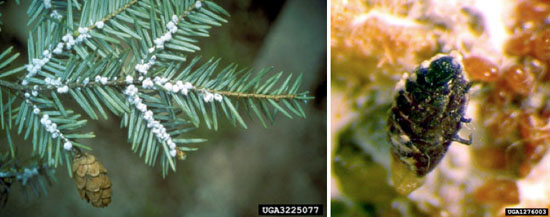Issue 8, June 11, 2010
Hemlock Wooly Adelgid: Know This Tree Killer!
The Hemlock Wooly Adelgid (Adelges tsugae) is an invasive species that was brought from Japan to the Western United States in the 1920's. The insect has since moved east and can now be found in Georgia, the Carolinas, through the Appalachian Mountains and in parts of the New England area. The Hemlock Wooly Adelgid is of particular concern because, unlike the Hemlocks in its native range in Japan, American hemlock species have no defenses against it. In addition, all members of adult adelgid populations are females that are capable of producing 50-300 eggs in their life time making infestations more intense. The result of an infestation is defoliation and eventually death of Hemlock trees within 4-6 years. In instances where infestations are severe, hemlock species can be completely removed from a forest. The impact is already clearly visible in the Great Smokey Mountains National Park.

The natural autumn landscape of the Smokey Mountains is broken up by gray patches of dead Hemlock trees (image courtesy of the National Park Service).
The presence of the Hemlock Wooly Adelgid is often indicated by little white cotton like balls along hemlock branches. These balls are adult adelgids that create a wooly waxy protective coating around themselves and their eggs. Without the coating the adelgid looks like a flat black oval approximately a millimeter in size.

Left: Adult Hemlock Wooly Adelgids in their waxy coating on a hemlock branch. Right: Adult Hemlock Wooly Adelgid with waxy coating removed. (images courtesy of invasive.org).
The Hemlock Wooly Adelgid is transported on smaller scales by birds, mammals, and wind and on a larger scale by the shipment of planting stock. There are a variety of methods being used and investigated to control wooly adelgid, including chemical and biological means, but a fully effective solution has not been found. To help slow the spread of the wooly adelgid make sure you do not transport Hemlock trees from infested areas. Also, if you make sure you have no bird feeders on or near Hemlock trees you will reduce the likelihood of transmission of the pest through birds. The Hemlock Wooly Adelgid has not been found in Illinois, so if you think you have found signs of this insect please contact the Illinois Cooperative Agricultural Pest Survey (CAPS).--Irenka Carney, research assistant with the Illinois CAPS program